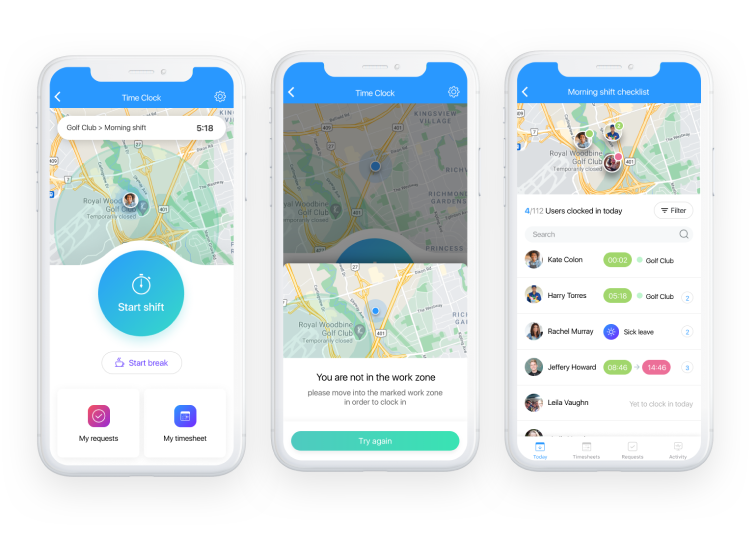The standard workweek isn’t for everyone. Some employees have other responsibilities outside of work, like going to school or raising children. The pandemic also affected how employees and companies schedule shifts.
Fortunately, you can keep things running smoothly with flexible scheduling. Flexible work schedules often provide better work-life balance and can lower employee stress.
The 9/80 work schedule is gaining momentum with companies and employees. Before implementing a 9/80 work schedule at your company, you should gain a solid understanding of its advantages and disadvantages and see if it is right for you.
We’ll also show you how Connecteam makes creating and managing schedules easy.
What Is a 9/80 Work Schedule?
So, what exactly is a 9/80 work schedule?
In the simplest terms, a 9/80 schedule is a compressed work schedule that has employees working eight 9-hour days, one 9-hour day, and one day off in a two-week period.
Usually, employees work eight hours on the fifth day of their first workweek. Then, they get the day off on the fifth day of their second workweek.
It’s much easier to understand a 9/80 work schedule in visual form. Here are two versions of what a typical 9/80 shift schedule might look like.
Schedule A – First Week:
| Day of the week | Hours worked |
| Monday | 9 |
| Tuesday | 9 |
| Wednesday | 9 |
| Thursday | 9 |
| Friday | 8 (split into two four-hour shifts) |
Schedule A – Second Week:
| Day of the week | Hours worked |
| Monday | 9 |
| Tuesday | 9 |
| Wednesday | 9 |
| Thursday | 9 |
| Friday | 0 (day off) |
Schedule B – First Week:
| Day of the week | Hours worked |
| Monday | 9 |
| Tuesday | 9 |
| Wednesday | 9 |
| Thursday | 9 |
| Friday | 4 |
Schedule B – Second Week:
| Day of the week | Hours worked |
| Monday | 9 |
| Tuesday | 9 |
| Wednesday | 9 |
| Thursday | 9 |
| Friday | 4 |
As you can see, flex scheduling provides many ways to schedule employees.

What Are the Benefits of Implementing a 9/80 Work Schedule?
An alternative work schedule can have perks for a business and its employees. Here are the main benefits of choosing a 9/80 work schedule for both employers and employees.
Benefits for employers
Implementing a 9/80 work schedule can be more beneficial than you might think. Here’s a look at the benefits of a 9/80 schedule for your company.
Improved employee retention
Many companies are in the middle of a retention crisis. Slack recently found that 57% of employees were open to finding a new job anytime.
One way to improve employee retention is by offering alternative work schedules. Providing flexible work schedules shows employees that your company listens to their concerns.
Gaining a competitive edge
Offering a flexible work schedule helps companies hold on to their current employees. But what about future employees you still need to hire?
Smaller companies can rarely match the benefits packages of their larger rivals.
But, according to Forbes, being flexible with schedules gives small companies a “competitive edge” during the hiring process. Many small businesses can offer a flexible work schedule that their larger competitors can’t match.
Better employee attendance
Uh oh, Susan called in… again. Darryl’s leaving early. And four employees are late!
If your employees show up late (or don’t show up at all), changing their work schedule could solve these problems.
The typical five-day workweek makes it challenging for employees to take care of their personal business. A 9/80 work schedule can give your employees an extended weekend, which helps boost employee attendance during the workweek.
Increased customer satisfaction
You probably know someone who’s a bundle of positive energy. It’s great to speak with these people because positivity is often contagious. Likewise, you likely feel down in the dumps after hanging around negative people.
When employees are happy, they share contagious positivity with their customers.
Benefits for employees
The benefits of a 9/80 work week aren’t only for employers. Here are a few reasons your employees will also enjoy scheduling flexibility.
Better work-life balance
According to Deloitte, 77% of full-time workers experience the feeling of burnout. Burnout sinks productivity and can cause conflicts between employees.
More often than not, burnout happens because employees have a poor work-life balance. A two-day weekend might not give your employees enough time to recharge.
Alternating work schedules provide a break from the standard eight-hour workday with a three-day weekend twice a month.
Increased productivity
According to Gartner, employees are 43% more productive when they have flexible work schedules. This schedule increases employee productivity because it gives employees an extra day off.
With an extra day off every two weeks, most employees feel compelled to work harder. This situation should result in increased productivity from your employees.
Happy employees
Creating alternating work schedules can help boost employee morale. Employees with a good work-life balance tend to bring the best versions of themselves to work.
Workers who can balance their work and personal lives are rarely distracted. They also feel less stressed out, which creates happy employees.
Having happy employees makes your workplace a less stressful and positive environment. Experiencing fewer work-related conflicts can also reduce the stress of your company’s HR department.
Easily Create Employee Schedules With Connecteam!
What Are the Drawbacks of a 9/80 Schedule?
A 9/80 work schedule has plenty of advantages. But this type of alternative work schedule also has a few drawbacks. Here are the challenges companies and employees can face working a 9/80 schedule.
Can cause burnout
Not everyone can work four nine-hour days in a row. But, over time, working longer-than-normal hours can cause employee burnout.
Common signs of burnout are:
- Increased absenteeism
- Drops in productivity
- Feelings of hostility or exhaustion
Paying more overtime hours
In the United States, paying overtime pay is a Federal law. Under the Fair Labor Standards Act, employers must pay employees 1.5 times their current wages.
Switching to a 9/80 work schedule could result in paying more overtime hours than expected. With a 9/80 schedule, employees typically work 36 hours one week and 44 hours the following week.
Before adopting this new schedule, make sure your company can afford to pay for any incurred overtime.
Difficulties covering shifts
Businesses might face difficulties covering all shifts when everyone’s on a 9/80 work schedule.
Fortunately, there are ways to work around potential scheduling problems:
- Use the employee scheduling app from Connecteam to have help monitoring work schedules. Connecteam helps reduce overtime hours by accurately tracking your employee’s hours and schedules.
- Require employees to have a replacement before switching shifts.
- Consider hiring enough team members to fill in when other employees are absent.
Do you want something different than the 9/80 work schedule? Check out our guide to the 4/10 working schedule — letting employees work 4 days a week with 10-hour shifts.
Complicating Sick Leave and Pay
Setting up a more flexible schedule can help ensure employees take fewer sick days to handle personal business. However, a new schedule can complicate previously created sick leave policies when an employee calls in.
For example, your company’s old schedule probably calculated a sick day as one eight-hour day. With a 9/80 work schedule, sick time could be as short as a four-hour shift or a nine-hour workday.
How to Start Your New 9/80 Work Schedule
Are you ready to try a new two-week schedule? Before you begin, follow these tips to get things off to a great start.
Use Connecteam to Save Time on Scheduling
If you’re still creating schedules manually with a pen and paper, or even worse… with Excel — you’re wasting a lot of time!
Scheduling employees shouldn’t take hours or days. Easily create and manage schedules using Connecteam’s employee management app.
Connecteam’s scheduling system allows you to effortlessly create and publish your schedules in minutes. Simple drag-and-drop features, recurring shifts, and templates make scheduling easy and efficient. Or, use the AI scheduler to instantly assign open shifts based on employee availability, preferences, and qualifications.
See Where Employees Clock in or Out
With Connecteam, business owners have complete oversight of when and where employees clock in or out. Connecteam’s GPS-powered time clock lets employees quickly clock in from their smartphone — no more outdated clock-in systems. With GPS tracking, you’ll always know where employees are working from.
Connecteam doesn’t stop with scheduling. In-shift attachments let you attach documents, pictures, and other information to a shift, giving each employee everything they need before clocking in. Plus, you save time answering questions from confused employees. Everyone wins!
No More Unwanted Scheduling Surprises
Stop scheduling conflicts with alerts that cover every shift. Your employees can find replacements in-app to prevent any last-minute dropped shifts. You can also set limitations, allowing only certain employees to cover specific shifts.
The potential overtime of a 9/80 work schedule won’t take you by surprise with Connecteam. That’s because Connecteam lets you set overtime limitation alerts. You can even clock employees out before they work a minute of overtime.

Instant Communication About Schedules
Ditch Slack, Teams, and WhatsApp — Connecteam is the last chat and messaging app your company needs. Use Connecteam’s employee directory to easily find and reach one employee, custom teams, or your entire workforce. No more missed calls, unread messages, or frustrating miscommunication!
Plus, Connecteam works with QuickBooks Online and Gusto. These integrations make it easy to pay your employees fast and without any guesswork.
Try the New Schedule Before Committing to It
It’s hard to know how well alternative work schedules will go without trying them. We suggest testing new work schedules for a few weeks or months before making any commitments.
You can see first-hand how employees handle shift coverage and their new working hours by testing alternative schedules.
Ask for a Few Volunteers
What if only some people want to work eight nine-hour days every two weeks? If that’s the case, consider testing a new schedule with some volunteers.
Chances are, the employees having difficulties with their current schedules will love to volunteer. You can also have half the team work a 9/80 work schedule for a larger sample size.
The Bottom Line
Flexible schedules give employees time to conduct personal business and take a break from the standard 40-hour workweek. Such a schedule typically leads to happier workers and increased employee productivity. But long hours and new schedules can be challenging.
Connecteam takes the headaches out of employee scheduling. Use Connecteam to easily create any work schedule in minutes.




